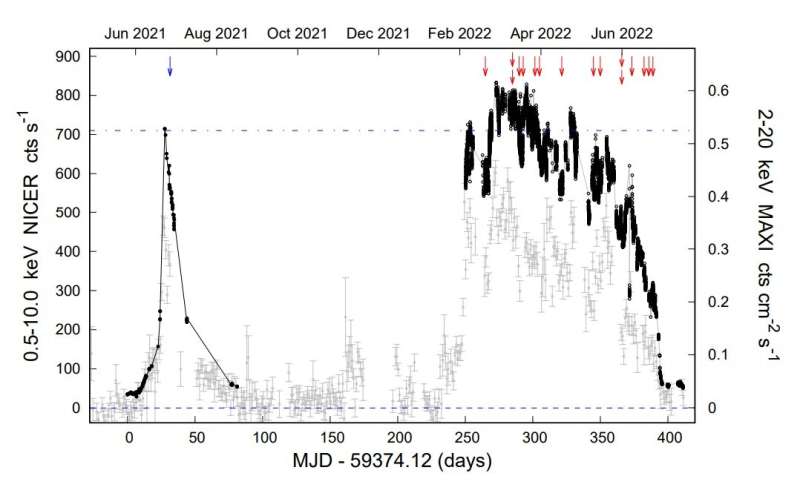April 27, 2023 report
This article has been reviewed according to Science X's editorial process and policies. Editors have highlighted the following attributes while ensuring the content's credibility:
fact-checked
peer-reviewed publication
trusted source
proofread
NICER detects quasi-periodic oscillations in X-ray binary 4U 1730–22

Using the Neutron Star Interior Composition Explorer (NICER) onboard the International Space Station (ISS), an international team of astronomers has detected millihertz quasi-periodic oscillations from a low-mass X-ray binary known as 4U 1730–22. The finding was reported in a paper published March 29 in the Monthly Notices of the Royal Astronomical Society.
X-ray binaries (XRBs) consist of a normal star or a white dwarf transferring mass onto a compact neutron star or a black hole. Based on the mass of the companion star, astronomers divide them into low-mass X-ray binaries (LMXB) and high-mass X-ray binaries (HMXB).
At a distance of some 22,500 light years away, 4U 1730–22 is a transient LMXB first detected in 1972. After its discovery, 4U 1730–22 was in outburst for approximately 200 days, until it entered a long-term quiescence phase lasting until June 2021. The source experienced a rapid brightening that year, showcasing a thermonuclear X-ray burst, hence confirming that the compact object in the system is a neutron star.
The latest outburst of 4U 1730–22 commenced in February 2022 and a team of researchers led by Giulio Cesare Mancuso of the La Plata National University in Argentina decided to perform NICER observations of this source in order to shed more light on its properties, which resulted in the detection of quasi-periodic oscillations (QPOs). In general, such oscillations are believed to occur when X-rays are emitted near the inner edge of an accretion disk in which gas swirls onto a compact object like a neutron star or a black hole.
"Throughout the 2022 outburst, we detected 45 instances of mHz QPOs with significances greater than 4σ and in data sets longer than 700 s in a total of 35 observations," the astronomers explained.
According to the study, the mHz QPO frequency was approximately constant within a data segment and between 4.5 and 8.1 mHz in the full data set, with an average fractional root-mean-square (rms) amplitude of the order of about 2%. The researchers noted that their findings are consistent with the frequency range of the mHz oscillations reported in other studied XRBs.
Moreover, the team found two cases in which the mHz oscillations were followed by a thermonuclear (type-I) X-ray burst and disappeared afterwards. The researchers explained that this is one of the main characteristics that separates mHz QPOs from other types of QPOs observed in neutron star X-ray binary systems systems.
The observations also found that 4U 1730–22 was in a soft spectral state during the QPO detections. Furthermore, it turned out that the mHz QPOs occurred when the system had a luminosity of approximately 1%–4% the value of the Eddington luminosity.
Summing up the results, the authors of the paper concluded that the mechanism responsible for the mHz QPOs is most likely associated with marginally stable nuclear burning (MSNB).
"We conclude that the mHz QPOs reported in this work are also associated with the MSNB, making 4U 1730–22 the eighth source that shows this phenomenology," the researchers wrote.
More information: G C Mancuso et al, Detection of millihertz quasi-periodic oscillations in the low-mass X-ray binary 4U 1730–22 with NICER, Monthly Notices of the Royal Astronomical Society (2023). DOI: 10.1093/mnras/stad949. on arXiv: arxiv.org/abs/2304.09935
Journal information: Monthly Notices of the Royal Astronomical Society , arXiv
© 2023 Science X Network





















